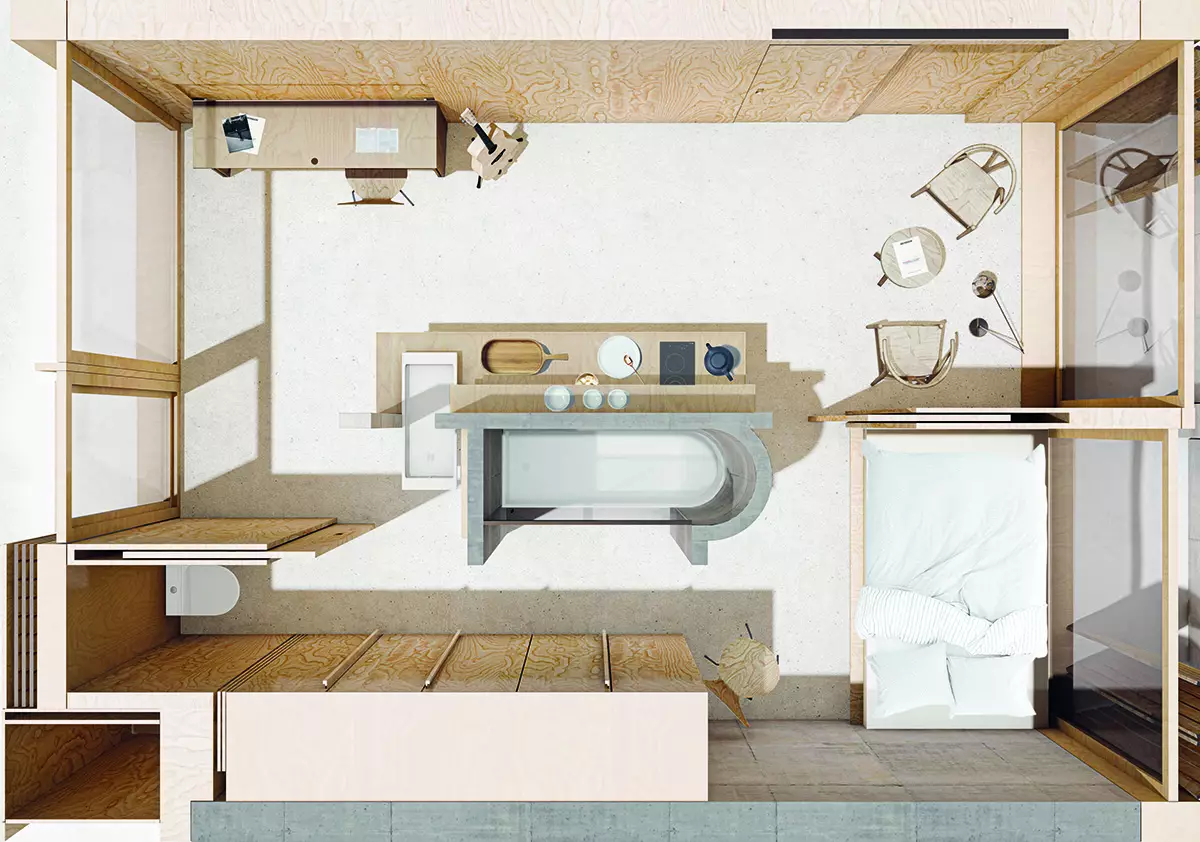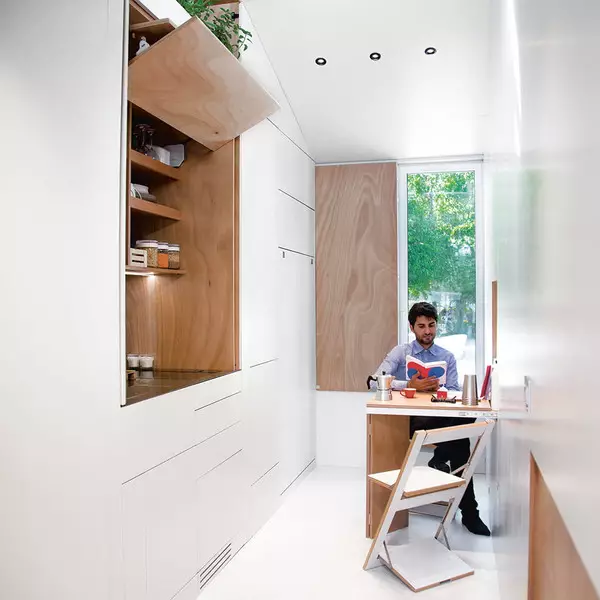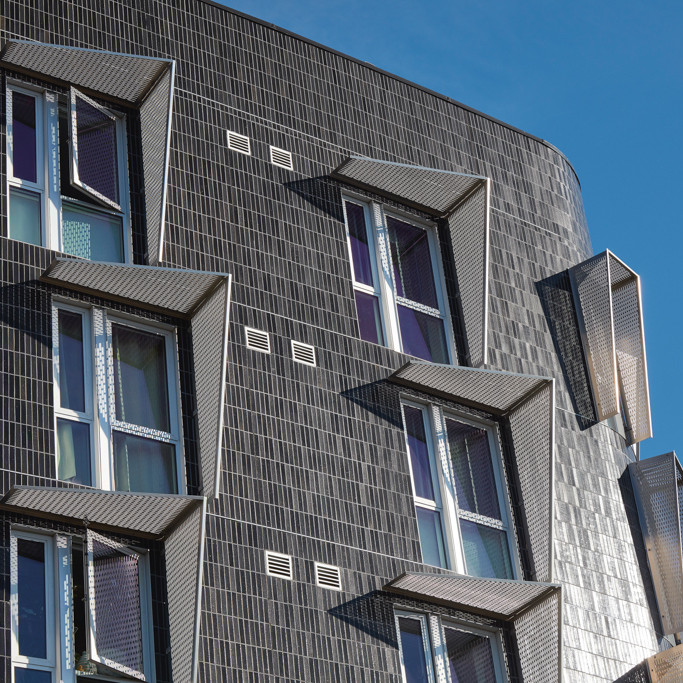Microliving – big opportunity for small spaces
Where living spaces are shrinking, innovative room concepts aren needed: Microliving is synonymous with an urban lifestyle and smart mini-apartments. Sliding solutions enable great comfort within a small living area.
Small but diverse
Swiss architects and room researchers from «kollektivorort» have devoted themselves to the subject of Microliving. In addition to historical and contextual classification they also examined the question of which structural/spatial means can help to give the “small ones” diversity.
You can get a comprehensive overview of Microliving and discover the creative impulses in the White Paper entitled “Microliving – Small but diverse”.
Discover the space miracle
The number one trick to gain more space: replacing unwieldy hinged doors with elegant sliding doors. Our floorplan of a micro-apartment demonstrates how this works.

Vistas in close quarters
Saving space with sliding doors means planning rooms with care. Together with Nathalie Birkhäuser and Roman Venzin, first-prize winners of the Hawa Student Award 2020, we drew a sample floorplan that offers lots of flexible design options.

Tiny but shiny
They are compact, sustainable and often mobile: the phenomenon known as “tiny houses.” Following the saying “less is more,” these mini houses bring together all the necessities of life within a very compact space.
And naturally, many constructing engineers rely on sliding solutions from Hawa Sliding Solutions.
aVOID by Leonardo di Chiara Mini-one by Rainer BorcherdingIdeas for Asia’s architecture scence
Singapore is considered the gate to Asia’s markets. The Hawa Experience Center has developed into an inspiration platform for architects and designers. In a short film, Stefano Mattioli, head of Hawa Sliding Solutions Asia and the Pacific explains how compact rooms can be efficiently used with sliding solutions.

“Micro” pays off many times over
Central location, practical infrastructure, fair costs – Microliving enables many people to enjoy an urban lifestyle. At the same time, the trend offers tangible advantages for investors.
Large floor plan, compact building
360° perspective on the megatrend microliving
Microliving in numbers
Micro-apartments are not the same as student apartments. Instead micro-apartments are gaining in popularity among more and more target groups – business people, expats, seniors and travelers. So we've identified the key drivers of this trend.
Living alone? A hundred years ago, hardly anyone would voluntarily agree to it. Purely out of great need, mainly widows, widowers and students would put up with such lodgings.
In the meantime, a radical change has taken place. The number one type of living situation in Europe is now the single-person household. One third of all households are composed of just one person. Sweden tops the charts of this trend globally, where more than half of all households have only one person. In Switzerland, the figure is 35 percent.
This societal development is expected to influence the apartment market over the longer-term. Previously apartments for singles were simply a smaller version of an apartment intended for an entire family. The future is likely to see the creation of smart mini-apartments – as part of the Microliving trend – that are entirely tailored to the needs of their occupants.
The bigger, the better: for decades this mantra governed the design of residential living areas in major industrialized nations. As a result, living spaces rose in size in line with economic growth. But a decade ago, signs of a change in this trend began to appear.
In cities around the world, the average per capita living space may have fallen in recent years – yet living comfort has not. After all, new living concepts combined with intelligent room design enable better use of space.
Average living space per residential unit in Switzerland, by construction period
2001 - 2005 131 square meters
2006 - 2010 125 square meters
2011 - 2015 115 square meters
2016 - 2018 105 square meters
Microliving is currently a hot topic among city planners. What exactly the term means always depends on context – on the project planners as well as the geographical location. In central Europe, Microliving refers to living space of around 30 square meters. In Asia the figure is smaller while in the US, it is larger.
Small living spaces are hardly new when it comes to city planning. Back in 1995, one in every five city dwellers in the world had only 20 square meters available, according to a United Nations study.
When welcoming their first child, many couples previously dreamed of an idyllic rural life and turned their backs to the city. That has changed. As pulsating nodes of contemporary experience, many metropolises around the world offer higher quality of life than outlying villages that have become rundown ghost towns.
The United Nations forecasts sound like revolution: four in five Europeans will live in a city by 2050. They are then estimated to number around 600 million people – 44 million more than today.
In 1950, there were just two cities with more than 10 million residents: Tokyo and New York City.
By 2010, there were already more than 26 megacities.
By 2030, the world will have an estimated 43 megacities.
Now in its fifth edition, Hawa Sliding Solutions has issued a call for submissions to up-and-coming architects from Switzerland, Germany and Austria for the most future-oriented solutions. The Hawa Student Award 2020 focused on developing plans for a block of 250 to 300 mini-apartments and common spaces – specifically for a disused property located in central Zurich.
Of the 36 submissions, in the end the jury selected three high-rise projects. A special issue of Hochparterre introduces the ideas that drive this next generation of architects.
To Hawa Product Finder
The Hawa Sliding Solutions range contains products and solutions for sliding, folding and stacking up to 500 kg - on buildings, in buildings and on fully-opening furniture.
